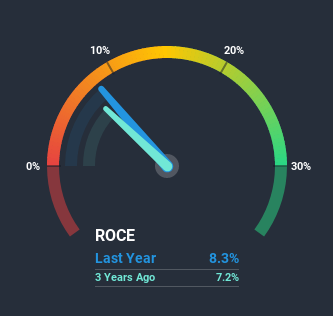Investors Could Be Concerned With KuibyshevAzot's (MCX:KAZT) Returns On Capital
If we want to find a potential multi-bagger, often there are underlying trends that can provide clues. In a perfect world, we'd like to see a company investing more capital into its business and ideally the returns earned from that capital are also increasing. Ultimately, this demonstrates that it's a business that is reinvesting profits at increasing rates of return. Although, when we looked at KuibyshevAzot (MCX:KAZT), it didn't seem to tick all of these boxes.
Return On Capital Employed (ROCE): What is it?
If you haven't worked with ROCE before, it measures the 'return' (pre-tax profit) a company generates from capital employed in its business. The formula for this calculation on KuibyshevAzot is:
Return on Capital Employed = Earnings Before Interest and Tax (EBIT) ÷ (Total Assets - Current Liabilities)
0.083 = ₽4.8b ÷ (₽68b - ₽9.9b) (Based on the trailing twelve months to September 2020).
Therefore, KuibyshevAzot has an ROCE of 8.3%. In absolute terms, that's a low return and it also under-performs the Chemicals industry average of 24%.
See our latest analysis for KuibyshevAzot

While the past is not representative of the future, it can be helpful to know how a company has performed historically, which is why we have this chart above. If you want to delve into the historical earnings, revenue and cash flow of KuibyshevAzot, check out these free graphs here.
What The Trend Of ROCE Can Tell Us
In terms of KuibyshevAzot's historical ROCE movements, the trend isn't fantastic. Over the last five years, returns on capital have decreased to 8.3% from 24% five years ago. And considering revenue has dropped while employing more capital, we'd be cautious. If this were to continue, you might be looking at a company that is trying to reinvest for growth but is actually losing market share since sales haven't increased.
The Bottom Line
In summary, we're somewhat concerned by KuibyshevAzot's diminishing returns on increasing amounts of capital. Yet despite these poor fundamentals, the stock has gained a huge 186% over the last five years, so investors appear very optimistic. In any case, the current underlying trends don't bode well for long term performance so unless they reverse, we'd start looking elsewhere.
On a final note, we've found 2 warning signs for KuibyshevAzot that we think you should be aware of.
If you want to search for solid companies with great earnings, check out this free list of companies with good balance sheets and impressive returns on equity.
If you’re looking to trade KuibyshevAzot, open an account with the lowest-cost* platform trusted by professionals, Interactive Brokers. Their clients from over 200 countries and territories trade stocks, options, futures, forex, bonds and funds worldwide from a single integrated account. Promoted
Valuation is complex, but we're here to simplify it.
Discover if KuibyshevAzot might be undervalued or overvalued with our detailed analysis, featuring fair value estimates, potential risks, dividends, insider trades, and its financial condition.
Access Free AnalysisThis article by Simply Wall St is general in nature. It does not constitute a recommendation to buy or sell any stock, and does not take account of your objectives, or your financial situation. We aim to bring you long-term focused analysis driven by fundamental data. Note that our analysis may not factor in the latest price-sensitive company announcements or qualitative material. Simply Wall St has no position in any stocks mentioned.
*Interactive Brokers Rated Lowest Cost Broker by StockBrokers.com Annual Online Review 2020
Have feedback on this article? Concerned about the content? Get in touch with us directly. Alternatively, email editorial-team (at) simplywallst.com.
About MISX:KAZT
KuibyshevAzot
Public Joint Stock Company KuibyshevAzot, together with its subsidiaries, engages in the manufacture, distribution, and sale of various chemicals in Russia, Asia, rest of Europe, and internationally.
Outstanding track record with flawless balance sheet.
Market Insights
Community Narratives



